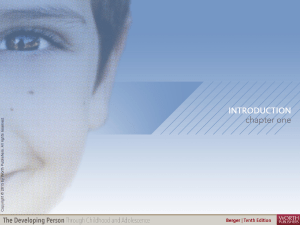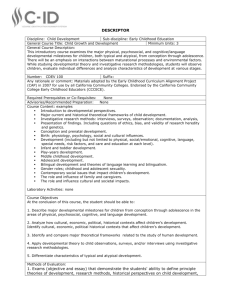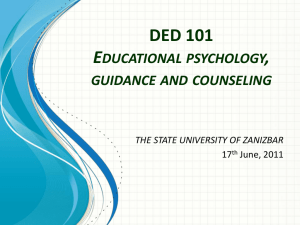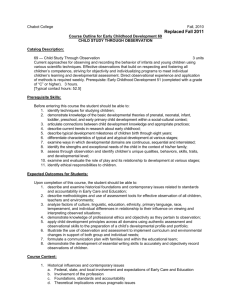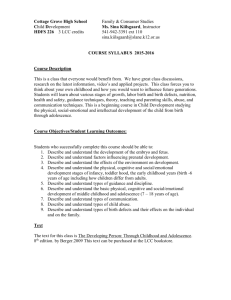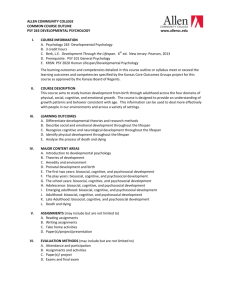Middle Childhood Development
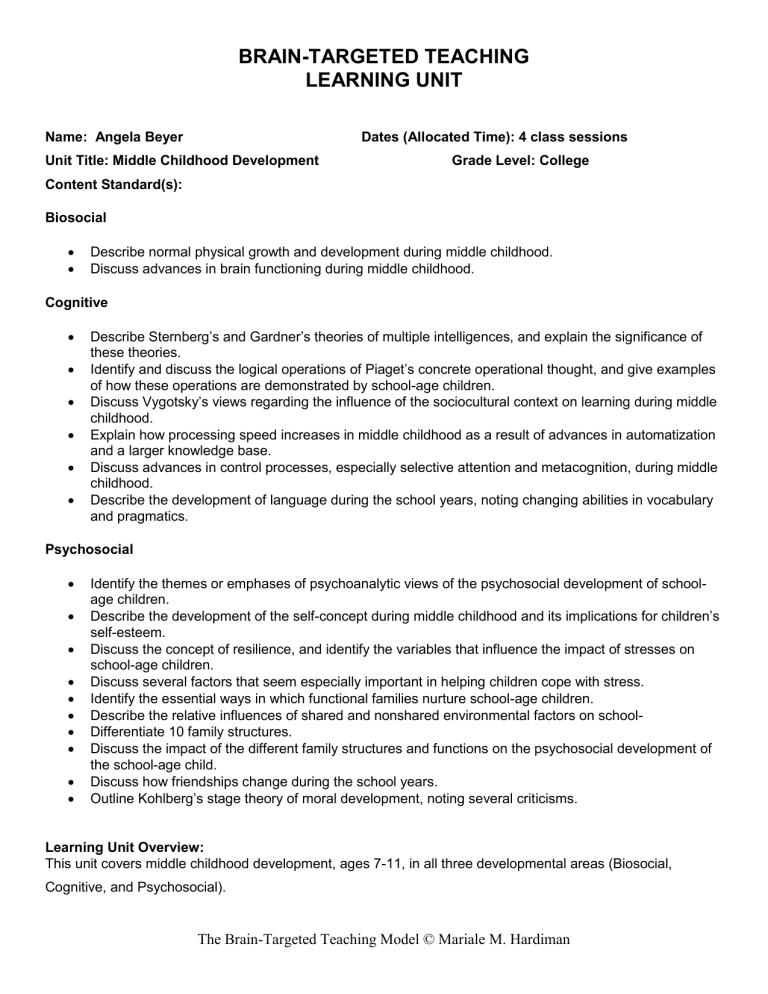
BRAIN-TARGETED TEACHING
LEARNING UNIT
Name: Angela Beyer
Unit Title: Middle Childhood Development
Content Standard(s):
Dates (Allocated Time): 4 class sessions
Grade Level: College
Biosocial
Describe normal physical growth and development during middle childhood.
Discuss advances in brain functioning during middle childhood.
Cognitive
Describe Sternberg’s and Gardner’s theories of multiple intelligences, and explain the significance of these theories.
Identify and discuss the logical operations of Piaget’s concrete operational thought, and give examples of how these operations are demonstrated by school-age children.
Discuss Vygotsky’s views regarding the influence of the sociocultural context on learning during middle childhood.
Explain how processing speed increases in middle childhood as a result of advances in automatization and a larger knowledge base.
Discuss advances in control processes, especially selective attention and metacognition, during middle childhood.
Describe the development of language during the school years, noting changing abilities in vocabulary and pragmatics.
Psychosocial
Identify the themes or emphases of psychoanalytic views of the psychosocial development of schoolage children.
Describe the development of the selfconcept during middle childhood and its implications for children’s self-esteem.
Discuss the concept of resilience, and identify the variables that influence the impact of stresses on school-age children.
Discuss several factors that seem especially important in helping children cope with stress.
Identify the essential ways in which functional families nurture school-age children.
Describe the relative influences of shared and nonshared environmental factors on school-
Differentiate 10 family structures.
Discuss the impact of the different family structures and functions on the psychosocial development of the school-age child.
Discuss how friendships change during the school years.
Outline Kohlberg’s stage theory of moral development, noting several criticisms.
Learning Unit Overview:
This unit covers middle childhood development, ages 7-11, in all three developmental areas (Biosocial,
Cognitive, and Psychosocial).
The Brain-Targeted Teaching Model © Mariale M. Hardiman
Brain Target #1
Emotional Connection: Many, if not most, of my students are longing for an emotional connection to not only the content, but myself as well as their classmates. Using this BT I attempt to create a connection to all three in a verity of way.
Predictability
Daily warm up question (first 5 minutes)
When students first arrive a question is posted on the board that covers content that will be discussed in that days class. This happens every class period and my greeting and intro is given
5 minutes after class start time.
Daily class outline sheet review
Daily class outline sheet is given with outline of what will be covered in that particular class.
Questions, comments or concerns from online content
Before we start new content, students are encouraged to ask questions make comments or state their concerns about anything from the previous class or the online content
Teacher – Student Connection
Personal check in during group work
During table group work, I attempt to touch base with EVERY student by making eye contact or having person touch with each student – so they know I am interested in them specifically.
Sharing of personal stories of my son in this age group
During each age group, I am able to use stories of my children to help my students not only connect with the material but also see I am human too.
Online announcements and discussion follow-up
Each week an online announcement is posted and I try to make weekly follow up discussion points within our online environment
Content – Student Connection
Group story sharing
Students are prompted in the online environment to come prepared with a particular content connection story. Then during a certain part of the class students share their story about the content connection with their table.
Picture Reel
Throughout the semester students bring in pictures that are of the age group we are discussing. I then take them home and add them to our picture reel that streams online with notes attached about that particular age group.
Video session online
Students watch videos (textbook created, home videos, and online found videos) that get them to see real life examples of classroom discussions.
Humor
Stories and videos that connect the funny side of this particular age group
Through the stories and videos I chose I try to pick some funny ones to create a good atmosphere and easy to connect with lesson
Music
Appropriate for this age
Student and Teacher selected
The music selected would be selections that are age/developmentally appropriate for this particular age group.
The Brain-Targeted Teaching Model © Mariale M. Hardiman
Brain Target #2
Physical Environment:
Though this BT is a little on the difficult side for me, thankfully I have supportive other faculty members that allow me to change the physical environment as I see fit. I do have about ten posters throughout the classroom that are about doing your best and the ability to change regardless of choices made before. Besides that, I put the students in charge of creating the environment with many different assignments and projects.
Novelty
Weekly bulletin board update
Each week prior to our class session, student groups must update our bulletin board with new content material. They include pictures, notes, drawings, articles, etc.
Change online entry photo w/ link weekly
The opening page to our online course has a picture that matches the age group we are discussing that week. Each week I go in and change the picture and include a link to an outside resource that pertains to that age group.
Sensory
Music selection for group work
The students select age/developmentally appropriate music to play during their group work. For example, during infancy they chose lullabies and instrumental music.
Order
Same daily routine
We go through the same daily routine of posted question, greeting, questions/comments/concerns, and then outline review so the students know what to expect
Easy to follow unit expectation list
At the beginning of the semester each unit has a list (kind of like this courses check list) of the expectations including readings, discussions, projects, assignments, etc.
Displays
Bulletin board display
By students and teacher
Section added weekly
Brain Target #3
Concept Map / Advanced Organizer:
In this course we use two different concept maps. The one below is used to remind them that all three developmental areas go into the development of the child – you can’t just isolate one without affecting the others. The students get this map at the beginning of the unit and added major info to surround and attach to each circle. The other map used is on a bulletin board and is a typical time line. Each developmental area is a different color and major milestones are added as the age is covered.
Biosocial Cognitive Psychosocial
Middle
Childhood
Developemnt
The Brain-Targeted Teaching Model © Mariale M. Hardiman
Learning Goals:
Describe typical development in all three developmental areas (biosocial, cognitive, and psychosocial) for middle childhood (7-11 years old).
Intr oductory “Big Picture” Activity
Students are asked to bring in a picture of themselves when they were 6/7 and another one of 11/12. They are then given a list of questions that get them to articulate some major changes they can see within the picture. After completing the questions and I review my pictures with them, they students engage in a table discussion about major differences among the photos. This allows them see some of the physical changes within their own context and then also see the wide range of differences among the group. We then use these pictures in our picture reel to use throughout the unit to discuss all three developmental areas.
Assessment of Prior Knowledge
On the first day of each unit, in our daily question, students are asked to describe a typical child in all three developmental areas of the prior unit. This allows me to see if there are any major topics missed or misunderstood so I can weave them throughout the current unit. I also use this question as a reference to the unit exam to see if scores are similar (and usually those who don’t do well on this question didn’t do well on the exam).
Brain Target #4
Activities for Teaching Mastery of Declarative/Procedural Knowledge
Many activities are done to help students develop mastery of declarative knowledge. These activities are done throughout each unit and are in addition to the small lecture piece of our face to face time. Students also have access to full lecture notes online.
Face To Face Activities
Daily Content Questions
Posted on board at beginning of class
Students may use all resources (book, phone, each other) and are encouraged to do so.
Create sequence charts
Students are given developmental milestones for typical age development and work with the table to put them in the correct order without using any resources besides each other. We then go over the correct order of the chart and then reference the textbook for further review.
Add to Concept Chart
Students add individual notes to own concept map in each developmental area and then share with table what they added. Students are able to use this particular concept map while taking the exam.
Online
Biosocial Quiz
Students are given a 15 question quiz covering biosocial development . The “catch” on this assignment is that students must earn a perfect score. The quiz is untimed and can be taken as many times as needed to earn a perfect score.
Developmental Video
Students just watch and see application and deeper explanation of all developmental areas
The Brain-Targeted Teaching Model © Mariale M. Hardiman
Brain Target #5
Activities for Extension and Application of Knowledge
This brain target is the one that most my students struggle with. They can memorize a bunch of facts but have yet developed the skills to apply the knowledge. With that said, we spend plenty of time to develop their skills in actually applying what they have mastered in the previous target.
Comparisons
Bulletin Board
After the bulletin board has been added to each week as a class we highlight major changes compared to prior age group in each area. After discussing the changes we talk about how those changes will affect skills and behaviors of the child.
Inductive Thinking
Personal picture use
This expands on the picture reel we put together. During online discussion time, students utilize pictures to demonstrate their understanding on different concepts. The pictures help to show differentiate among children and the students’ ability to not only identify but apply knowledge base.
Deductive Thinking
Picture/Video exercise
Students are shown a picture/video and based on what we know about this age group they try to describe what will happen next. Each table has to come up with a scenario and use our textbook and/or notes to support their statements.
Investigation
For each age group students conduct a specific age group observation. For this particular age group I have my sons’ class come in and visit my classroom. I have different stations for the children go to that demonstrate different concepts being taught in each developmental area. My students then must observe and apply the concepts we discussed in class to what the children are doing in front of them.
Real-World Context
Online discussions help students apply concept to own experiences and life. Weekly questions are posted that allow them to find out information about their own life and put it in the context of this class.
Brain Target #6
Evaluating Learning
My class is filled with a large range of types of students. Most of the young students have gone through the CA system that is all just about STARS testing, which is just recall based, not application based. Where other students are returning students th at either have never been to college or it has been so long they don’t recall the evaluation process. Keeping that in mind I try to utilize a large array of evaluating instruments.
Daily Questions
Biosocial Quiz
Online Discussions
Video Assignment
Observation Paper
Bulletin Board (Group)
Case Study Presentation (Group)
Unit Exam
The Brain-Targeted Teaching Model © Mariale M. Hardiman

